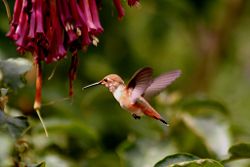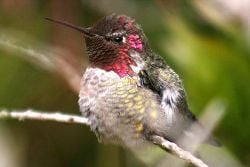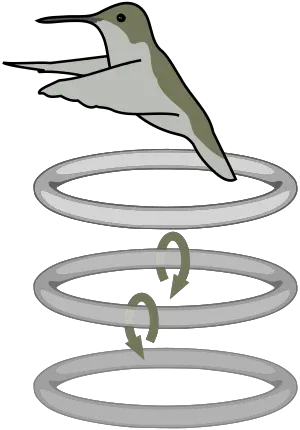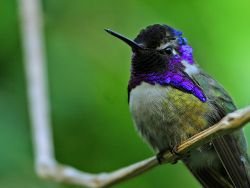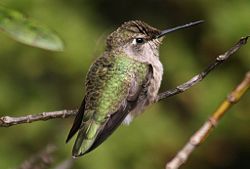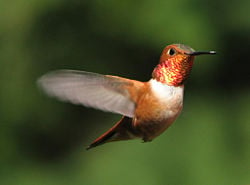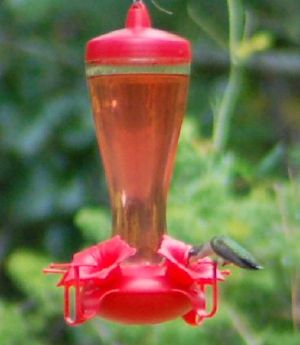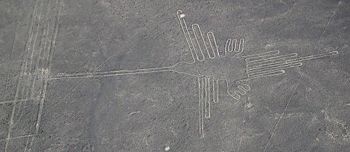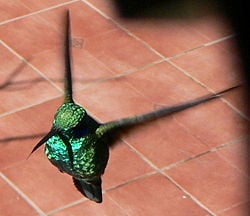Hummingbird
| Hummingbird | ||||||||||
|---|---|---|---|---|---|---|---|---|---|---|
| Scientific classification | ||||||||||
| ||||||||||
|
Phaethornithinae
For an alphabetic species list, see:
|
Hummingbirds are the smallest of all known birds, native only to the Americas. They are known for their ability to hover in mid-air by rapidly flapping their wings up to 80 times per second (depending on the species). The Giant Hummingbird's wings beat 8–10 times per second, the wings of medium sized hummingbirds beat about 20–25 times per second and the smallest beat 70 times per second. They are capable of sustained hovering and are the only birds able to fly backwards ( Ridgely et al. 2001) or vertically, and to maintain position while drinking from flower blossoms. They are named for the characteristic humming sound made by their wings.
Hummingbirds are attracted to many types of flowering plants : shrimp plants, bee balm, heliconia, butterfly bush, hibiscus, bromeliads, cannas, verbenas, honeysuckles, salvias, pentas, fuchsias, many penstemons. It is often stated that they are especially attracted to red and yellow flowers. They feed on the nectar of these plants and are important pollinators, especially of deep-throated flowers. Most species of hummingbird also eat insects, especially when they are feeding their young.
Male hummingbirds usually take no part in nesting. Most species make a neatly woven cup in a tree branch. Two white eggs are laid, which despite being the smallest of all bird eggs, are in fact large relative to the hummingbird's adult size. Incubation is typically 14–19 days.
Appearance
The hummingbird is a small bird with a long, thin beak. This elongated beak is one of the defining characteristics of the hummingbird, which, with an extendable, bifurcated tongue, has evolved in order to allow the bird to feed upon nectar deep within flowers. A hummingbird's lower beak also has the unique ability to flex downward to create a wider opening, facilitating the capture of insects in the mouth rather than at the tip of the beak (Omara-Otunnu 2004). Hummingbird's Beaks Bend To Catch Insects. University of Connecticut Advance (2004-07-19).</ref>
The Bee Hummingbird (Mellisuga helenae) is the smallest bird in the world, weighing 1.8 grams and measuring about 5 cm . A more typical hummingbird, such as the Rufous Hummingbird (Selasphorus rufus), weighs approximately 3 g and has a length of 10–12 cm . The largest hummingbird is the Giant Hummingbird (Patagona gigas), with some individuals weighing as much as 24 grams and measuring 21.5 cm . Most species, however, weigh 2.5–6.5 g and are 6 –12 cm in length. Hummingbirds bear the most glittering plumage in the bird world. They display sexual dimorphism, as male hummingbirds are usually more brightly colored, while females of most species display more cryptic coloration.[1] Most males have iridescent plumage, in metallic red, orange, green and/or blue. Some have only an iridescent throat patch or cap, while others, such as the Coppery-headed Emerald are entirely iridescent.[2]
Aerodynamics of flight
Hummingbird flight has been studied intensively from an aerodynamic perspective: Hovering hummingbirds may be filmed using high-speed video cameras.
Writing in Nature, biomechanist Douglas Warrick and coworkers studied the Rufous Hummingbird, Selasphorus rufus, in a wind tunnel using particle image velocimetry techniques and investigated the lift generated on the bird's upstroke and downstroke. They concluded that their subjects produced 75% of their weight support during the down-stroke and 25% during the up-stroke: many earlier studies had assumed (implicitly or explicitly) that lift was generated equally during the two phases of the wingbeat cycle, as is the case of insects of a similar size. This finding shows that hummingbirds' hovering is similar to, but distinct from, that of hovering insects such as the hawk moths. [4]
Metabolism
With the exception of insects, hummingbirds while in flight have the highest metabolism of all animals, a necessity in order to support the rapid beating of their wings. Their heart rate can reach as high as 1,260 beats per minute, a rate once measured in a Blue-throated Hummingbird [1]. They also typically consume more than their own weight in food each day, and to do so they must visit hundreds of flowers daily. At any given moment, they are only hours away from starving. However, they are capable of slowing down their metabolism at night, or any other time food is not readily available. They enter a hibernation-like state known as torpor. During torpor, the heart rate and rate of breathing are both slowed dramatically (the heart rate to roughly 50–180 beats per minute), reducing their need for food.
Studies of hummingbirds' metabolism are highly relevant to the question of whether a migrating Ruby-throated Hummingbird can cross 800 km (500 miles) of the Gulf of Mexico on a nonstop flight, as field observations suggest it does. This hummingbird, like other birds preparing to migrate, stores up fat to serve as fuel, thereby augmenting its weight by as much as 40–50 percent and hence increasing the bird's potential flying time.[5]
Range
Hummingbirds are found only in the Americas, from southern Alaska and Canada to Tierra del Fuego, including the Caribbean. The majority of species occur in tropical Central and South America, but several species also breed in temperate areas. Excluding vagrants, sometimes from Cuba or the Bahamas, only the migratory Ruby-throated Hummingbird breeds in eastern North America. The Black-chinned Hummingbird, its close relative and another migrant, is the most widespread and common species in the western United States and Canada.
Most hummingbirds of the U.S. and Canada migrate to warmer climates in the northern winter, but some remain in the warmest coastal regions. Some southern South American forms also move to the tropics in the southern winter.
The Rufous Hummingbird shows an increasing trend to migrate east to winter in the eastern United States, rather than south to Central America, as a result of increasing survival prospects provided by artificial feeders in gardens. In the past, individuals that migrated east would usually die, but now many survive, and their changed migration direction is inherited by their offspring. Provided sufficient food and shelter is available, they are surprisingly hardy, able to tolerate temperatures down to at least -20 °C (-4 °F).
Systematics and evolution
Traditionally, hummingbirds are placed in the order Apodiformes, which also contains the swifts. In the Sibley-Ahlquist taxonomy, hummingbirds are separated as a new order, Trochiliformes, but this is not well supported by additional evidence. Hummingbirds' wings are hollow and fragile, making fossilization difficult and leaving their evolutionary history a mystery. Some scientists also believe that the hummingbird evolved relatively recently. Scientists also theorize that hummingbirds originated in South America, where there is the greatest species diversity. Brazil and Ecuador contain over half of the known species.
There are between 325 and 340 species of hummingbird, depending on taxonomic viewpoint, historically divided into two subfamilies, the hermits (subfamily Phaethornithinae, 34 species in six genera), and the typical hummingbirds (subfamily Trochilinae, all the others).
The modern diversity of hummingbirds is thought by evolutionary biologists to have evolved in South America, as the great majority of the species are found there. However, the ancestor of extant hummingbirds may have lived in parts of Europe to what is southern Russia today.
Genetic analysis[citation needed] has indicated that the hummingbird lineage diverged from their closest relatives some 35 million years ago, in the Late Eocene, but fossil evidence is limited. Fossil hummingbirds are known from the Pleistocene of Brazil and the Bahamas—though neither has yet been scientifically described—and there are fossils and subfossils of a few extant species known, but until recently, older fossils had not been securely identifiable as hummingbirds.
In 2004, Dr. Gerald Mayr of the Senckenberg Museum in Frankfurt am Main identified two 30-million-year-old hummingbird fossils and published his results in Nature.[6] The fossils of this primitive hummingbird species, named Eurotrochilus inexpectatus ("unexpected European hummingbird"), had been sitting in a museum drawer in Stuttgart; they had been unearthed in a clay pit at Wiesloch-Frauenweiler, south of Heidelberg, Germany and, because it was assumed that hummingbirds never occurred outside the Americas, were not recognized to be hummingbirds until Mayr took a closer look at them.
Fossils of birds not clearly assignable to either hummingbirds or a related, extinct family, the Jungornithidae, have been found at the Messel pit and in the Caucasus, dating from 40–35 mya, indicating that the split between these two lineages indeed occurred at that date. The areas where these early fossils have been found had a climate quite similar to the northern Caribbean or southernmost China during that time. The biggest remaining mystery at the present time is what happened to hummingbirds in the roughly 25 million years between the primitive Eurotrochilus and the modern fossils. The astounding morphological adaptations, the decrease in size, and the dispersal to the Americas and extinction in Eurasia all occurred during this timespan. DNA-DNA hybridization results [7] suggest that the main radiation of South American hummingbirds at least partly took place in the Miocene, some 12–13 mya, during the uplifting of the northern Andes.
Lists of species and genera
- Alphabetical list
- List of hummingbirds in taxonomic order
Hummingbirds and humans
Hummingbirds sometimes fly into garages and become trapped. It is widely believed that this is because they mistake the hanging (usually red-color) door-release handle for a flower, although hummingbirds can also get trapped in enclosures that do not contain anything red. Once inside, they may be unable to escape because their natural instinct when threatened or trapped is to fly upward. This is a life-threatening situation for hummingbirds, as they can become exhausted and die in a relatively short period of time, possibly as little as an hour. If a trapped hummingbird is within reach, it can often be caught gently and released outdoors. It will lie quietly in the space between cupped hands until released.
Feeders and nectar
The diet of hummingbirds requires an energy source (typically nectar) and a protein source (typically small insects). Providing many plants that carry blooms used by hummingbirds is the safest way to provide nectar for hummingbirds. Through careful plant selection, gardens may contain plants that bloom at different times to attract hummingbirds throughout the seasons they are present in an area. Placing these plants near windows affords a good view of the birds. Hummingbirds will take synthetic nectar from artificial feeders. Such feeders allow people to observe and enjoy hummingbirds up-close while providing the hummingbirds with a reliable supply of nectar, especially when flower blossoms are less abundant. Maintaining cleanliness of the feeder is essential for the health of the birds. Homemade nectar can be made from 1 part white, granulated table sugar to 4 parts water, boiled to make it easier to dissolve the sugar and to purify the solution so that it will stay fresh longer. The water should be boiled before measuring to ensure that the ratio of sugar to water remains 1–4. The cooled nectar is then poured into the feeder.
Things to avoid using in feeders include honey, which should not be used because it is prone to culture bacteria dangerous to hummingbirds.[8] Artificial sweeteners should also be avoided because, although the hummingbirds will drink it, they will be starved of the calories they need to sustain their metabolism. Some commercial hummingbird foods contain red dyes and preservatives, which are unnecessary and possibly dangerous to the birds, so dyes and preservatives should be avoided because neither have been studied for long-term effects on hummingbirds. While it is true that bright colors, especially red, initially attract hummingbirds more quickly than others, it is better to use a feeder that has some red on it, rather than coloring the liquid offered in it. It is possible that red dye is harmful to hummingbirds.[9] Commercial nectar mixes may contain small amounts of mineral nutrients which are useful to hummingbirds, but hummingbirds get all the nutrients they need from the insects they eat, not from nectar, so the added nutrients also are unnecessary. Authorities on hummingbirds recommend that if you use a feeder, use just plain sugar and water.[10]
A hummingbird feeder should be easy to refill and keep clean. Prepared nectar can be refrigerated for 1–2 weeks before being used, but once placed outdoors it will only remain fresh for 2–4 days in hot weather, or 4–6 days in moderate weather, before turning cloudy or developing mold. When changing the nectar, the feeder should be rinsed thoroughly with warm tap water, flushing the reservoir and ports to remove any contamination or sugar build-up. If dish soap is used, it always needs extra rinsing so that no residue is left behind. The feeder can be soaked in dilute chlorine bleach if black specks of mold appear and rinsed with clear water.
Other animals are also attracted to hummingbird feeders. It is a good idea to get a feeder that has very narrow ports, or ports with mesh-like "wasp guards", to prevent bees and wasps from getting inside where they get trapped. Orioles, woodpeckers, banaquits, and other animals are known to drink from hummingbird feeders, sometimes tipping them and draining the liquid. If this becomes a problem, it is possible to buy feeders which are specifically designed to support their extra weight and which hummingbirds will use too. If ants find your hummingbird feeder, one solution is to install an "ant moat", which is available at specialty garden stores and online, or tanglefoot can be used to trap the ants, provided it is applied in a location totally inaccessible to the hummingbirds. You can also place vaseline on the pole that holds the feeder to trap ants on the path that they create.
Sometimes a large hummingbird drives its smaller brethren away from a feeder. An effective solution is to put out a second feeder that contains a slightly lower sugar concentration. Hummingbirds can detect a feeding source that is denser in sugar by only a few percent, and the more aggressive bird will make that feeder its own. The smaller birds will flock to the remaining feeder.
In myth and culture
- The Aztec god Huitzilopochtli is often depicted as a hummingbird. The Nahuatl word huitzil (hummingbird) is an onomatopoeic word derived from the sounds of the hummingbird's wing-beats and zooming flight.
- One of the Nazca Lines, displayed at right, depicts a hummingbird.
- The Ohlone tells the story of how a Hummingbird brought fire to the world. See article at the National Parks Conservation Association's website for a recounting.
- Trinidad and Tobago is known as "The land of the hummingbird," and a hummingbird can be seen on that nation's coat of arms,1 cent coin as well as its national airline, "Caribbean Airlines".
- Many popular songs have been written under the title "Hummingbird", including separate works by B.B. King, Wilco, Leon Russell, John Mayer, Frankie Laine, Cat Stevens, Seals and Crofts, Merzbow and Yuki.
- Several companies use a hummingbird as a corporate logo. Such companies include Canadian CHC Helicopter Corporation, British Colibri, and American Hummingbird Scientific.
- In Brazil a black humming bird of any kind is a sign of death in the family, especially inside the house.
See also
- Hummingbird Hawk-moth (Macroglossum stellatarum)
- Hemaris, another genus of sphinx moths confused with hummingbirds
- Bird feeder, for information about hummingbird feeders.
ReferencesISBN links support NWE through referral fees
- Omara-Otunnu, E. 2004. Hummingbird's Beaks Bend To Catch Insects ,Advance,University of Connecticut ,[2]].website visited 8-9-07
- Ridgely ,R.S. and P.G. Greenfield . 2001 . "The Birds of Ecuador: Field Guide",volume 2 , Cornell University Press.
- del Hoyo, J., A. Elliott, J. Sargatal, (editors) 1999. Handbook of Birds of the World, Volume 5: Barn-owls to Hummingbirds. Lynx Edicions, Barcelona. ISBN 84-87334-25-3
- Gerwin , J.A.,R. M. Zink . 1998 . Phylogenetic patterns in the Trochilidae. Auk 115(1): 105-118. PDF fulltext
- Meyer de Schauensee, Rodolphe (1970): A Guide to Birds of South America. Livingston, Wynnewood, PA.
- Biological Journal of the Linnean Society (1998), 65: 63; 77
External links
- The Official Hummingbird Forum
- Hummingbirds.net
- The Hummingbird Society
- Ruby Throat Hummingbird Project
- Ecuador Hummingbirds and Climate Change
- Hummingbird species
Credits
New World Encyclopedia writers and editors rewrote and completed the Wikipedia article in accordance with New World Encyclopedia standards. This article abides by terms of the Creative Commons CC-by-sa 3.0 License (CC-by-sa), which may be used and disseminated with proper attribution. Credit is due under the terms of this license that can reference both the New World Encyclopedia contributors and the selfless volunteer contributors of the Wikimedia Foundation. To cite this article click here for a list of acceptable citing formats.The history of earlier contributions by wikipedians is accessible to researchers here:
The history of this article since it was imported to New World Encyclopedia:
Note: Some restrictions may apply to use of individual images which are separately licensed.
- ↑ http://animaldiversity.ummz.umich.edu/site/accounts/information/Trochilidae.html
- ↑ http://www.montereybay.com/creagrus/hummingbirds.html
- ↑ Rayner, J.M.V. 1995. Dynamics of vortex wakes of flying and swimming vertebrates. J. Exp. Biol. 49:131–155.
- ↑ Warrick, D. R.; Tobalske, B.W. & Powers, D.R. (2005): Aerodynamics of the hovering hummingbird. Nature 435: 1094–1097 DOI:10.1038/nature03647 (HTML abstract)
- ↑ Skutch, Alexander F. & Singer, Arthur B. (1973): The Life of the Hummingbird. Crown Publishers, New York. ISBN 0-517-50572-X
- ↑ http://www.cbc.ca/health/story/2004/05/06/bird_fossils040506.html
- ↑ Bleiweiss, Robert; Kirsch, John A. W. & Matheus, Juan Carlos (1999): DNA-DNA hybridization evidence for subfamily structure among hummingbirds. Auk 111(1): 8–19. PDF fulltext
- ↑ http://faq.gardenweb.com/faq/lists/hummingbird/2003021845028716.html
- ↑ http://www.hummingbirds.net/dye.html
- ↑ Shackelford, Clifford Eugene; Lindsay, Madge M. & Klym, C. Mark (2005): Hummingbirds of Texas with their New Mexico and Arizona ranges. Texas A&M University Press, College Station. ISBN 1-58544-433-2
